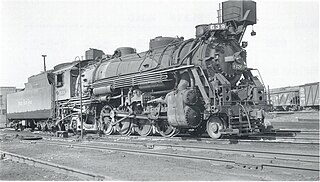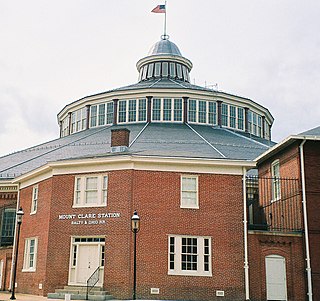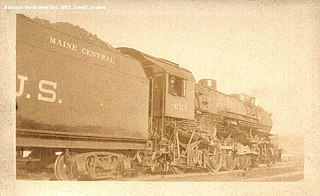Under the Whyte notation for the classification of steam locomotives, 2-10-0 represents the wheel arrangement of two leading wheels on one axle, ten powered and coupled driving wheels on five axles, and no trailing wheels. This arrangement was often named Decapod, especially in the United States, although this name was sometimes applied to locomotives of 0-10-0 "Ten-Coupled" arrangement, particularly in the United Kingdom. Notable German locomotives of this type include the war locomotives of Class 52.
Under the Whyte notation for the classification of steam locomotives, 2-10-2 represents the wheel arrangement of two leading wheels, ten powered and coupled driving wheels, and two trailing wheels. In the United States and elsewhere the 2-10-2 is known as the Santa Fe type, after the Atchison, Topeka and Santa Fe Railway that first used the type in 1903.

Under the Whyte notation for the classification of steam locomotives, 2-8-2 represents the wheel arrangement of two leading wheels on one axle, usually in a leading truck, eight powered and coupled driving wheels on four axles and two trailing wheels on one axle, usually in a trailing truck. This configuration of steam locomotive is most often referred to as a Mikado, frequently shortened to Mike.
Locomotive classification on the Pennsylvania Railroad took several forms. Early on, steam locomotives were given single-letter classes. As the 26 letters were quickly assigned, that scheme was abandoned for a more complex system. This was used for all of the PRR's steam locomotives, and — with the exception of the final type bought — all electric locomotives also used this scheme.

The B&O Railroad Museum is a museum and historic railway station exhibiting historic railroad equipment in Baltimore, Maryland. The Baltimore and Ohio Railroad (B&O) company originally opened the museum on July 4, 1953, with the name of the Baltimore & Ohio Transportation Museum. It has been called one of the most significant collections of railroad treasures in the world and has the largest collection of 19th-century locomotives in the U.S. The museum is located in the Baltimore and Ohio Railroad's old Mount Clare Station and adjacent roundhouse, and retains 40 acres of the B&O's sprawling Mount Clare Shops site, which is where, in 1829, the B&O began America's first railroad and is the oldest railroad manufacturing complex in the United States.
Under the Whyte notation for the classification of steam locomotives, 0-8-0 represents the wheel arrangement of no leading wheels, eight powered and coupled driving wheels on four axles and no trailing wheels. Locomotives of this type are also referred to as eight coupled.
The USRA 0-8-0 was a USRA standard class of steam locomotive designed under the control of the United States Railroad Administration, the nationalized railroad system in the United States during World War I. This was the standard heavy switcher locomotive of the USRA types, and was of 0-8-0 wheel arrangement in the Whyte notation, or "D" in UIC classification.

The USRA Light Mikado was a USRA standard class of steam locomotive designed under the control of the United States Railroad Administration, the nationalized railroad system in the United States during World War I. This was the standard light freight locomotive of the USRA types, and was of 2-8-2 wheel arrangement in the Whyte notation, or 1′D1′ in UIC classification.

The USRA Heavy Mikado was a USRA standard class of steam locomotive designed under the control of the United States Railroad Administration (USRA), the nationalized railroad system in the United States during World War I. These locomotives were of 2-8-2 wheel arrangement in the Whyte notation, or 1′D1′ in UIC classification. A total of 233 locomotives were built to this plan for the USRA; postwar, it became a de facto standard design, which was built to the total of 957 locomotives including the USRA originals and all subsequent copies.
On the Baltimore and Ohio Railroad, locomotives were always considered of great importance, and the railroad was involved in many experiments and innovations.

Southern Pacific 745 is a preserved Mikado-type steam locomotive that was fabricated at the Southern Pacific Railroad's Algiers Shops at Algiers Point directly across the Mississippi River from New Orleans. With a 2-8-2 wheel configuration, 745 was built as a freight engine for the Southern Pacific Railroad Company. The locomotive returned to service in 2004 after a restoration period and is now housed on a short spur line in suburban Jefferson Parish. It is currently the only operating steam locomotive in Louisiana.

Pennsylvania Railroad Class L1s were 2-8-2 "Mikado"-type steam locomotives that were used on the Pennsylvania Railroad during the early twentieth century. These 574 locomotives were manufactured between 1914 and 1919 by the railroad's own Juniata Shops as well as the Baldwin Locomotive Works (205) and the Lima Locomotive Works (25).

St. Louis–San Francisco 4018 is a class USRA Light 2-8-2 "Mikado" steam locomotive which operated for three decades hauling freight between Bessemer and Birmingham, Alabama, on the St. Louis–San Francisco Railway. It went on display at the Alabama State Fairgrounds in 1952 and is one of only a few locomotives of its type that survive.
The Pennsylvania Railroad's class L2s was a class of USRA Light Mikados originally purchased (1919) for the subsidiary Grand Rapids and Indiana Railroad. Similar in size to the home-designed and built L1s, the L2s was easily distinguishable by their radial-stay fireboxes and Hodges fabricated trailing trucks. They were built by ALCO. All were retired in 1948.

St. Louis–San Francisco 4003 is a 2-8-2, Mikado type, standard gauge steam railway locomotive built by the American Locomotive Company in 1919 as a standard USRA Light Mikado for the Pennsylvania Railroad. The PRR, for unknown reasons, rejected 33 of 38 locomotives in the order. The United States Railroad Administration reassigned 23 of them to the St. Louis–San Francisco Railway (SLSF), also known as the "Frisco". The Frisco also received 10 sisters from the Indiana Harbor Belt Railroad, making 33 in all. The locomotive is now on display at the Fort Smith Trolley Museum in Fort Smith, Arkansas.

Maine Central Railroad Class S locomotives were intended for heavy freight service. They were of 2-8-2 wheel arrangement in the Whyte notation, or " 1'D1' " in UIC classification. They replaced earlier class W 2-8-0 locomotives beginning in 1914. They were the largest and most modern steam freight locomotives built for Maine Central; although former Boston and Maine Railroad 2-10-2s were later purchased to handle World War II freight traffic. Class S locomotives pulled freight trains over the main line between Portland and Bangor, Maine; and are best remembered for service on the Mountain Division from 1929, when the class X Mallet locomotives were scrapped, until replacement by diesel locomotives in the early 1950s.
The USRA Heavy Mountain was a USRA standard class of steam locomotive designed under the control of the United States Railroad Administration, the nationalized railroad system in the United States during World War I. This was the standard light freight locomotive of the USRA types, and was of 4-8-2 wheel arrangement in the Whyte notation, or 2′D1′ in UIC classification.

Baltimore and Ohio 4500 is a 2-8-2 "USRA Light Mikado" steam locomotive built by the Baldwin Locomotive Works in Philadelphia, Pennsylvania in July 1918 for the Baltimore and Ohio Railroad (B&O) as a member of the Q-3 class.

The Manila Railroad 200 class were 2-10-2 Santa Fe steam locomotives operated by the Manila Railroad Company (MRR), predecessor of the Philippine National Railways. They were built alongside the 4-8-2 Mountain-type 170 class by the American Locomotive Company at its Brooks facility between 1921 and 1922. During its service at the MRR, it carried heavy freight trains on the South Main Line between Manila and the Bicol Region.
Chicago, Burlington and Quincy 4963 is a preserved class "O-1a" 2-8-2 "Mikado" type steam locomotive originally built by the Baldwin Locomotive Works in 1923 for the Chicago, Burlington and Quincy Railroad. It was used by the CB&Q to haul mainline freight trains before it was leased to the Bevier and Southern Railroad to haul short-distance freight trains in the early 1960s. It was subsequently retained by the CB&Q and used as a source of spare parts before being acquired by Richard Jensen.













